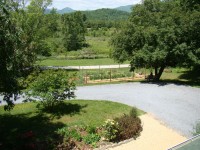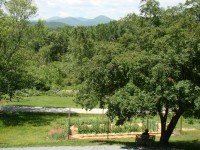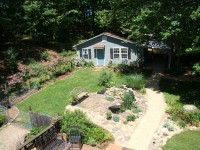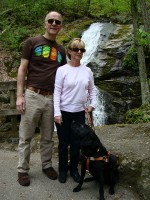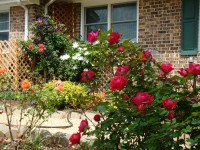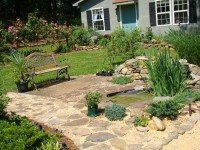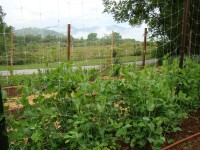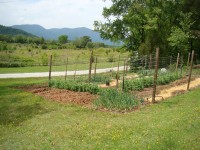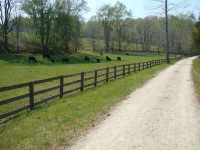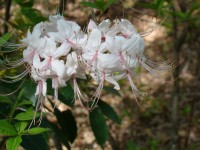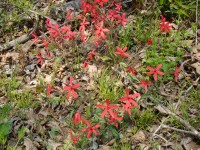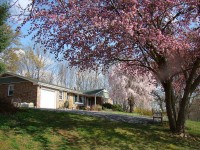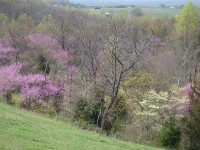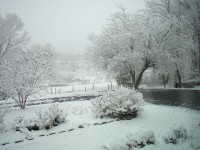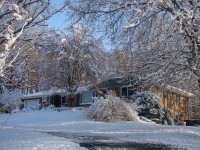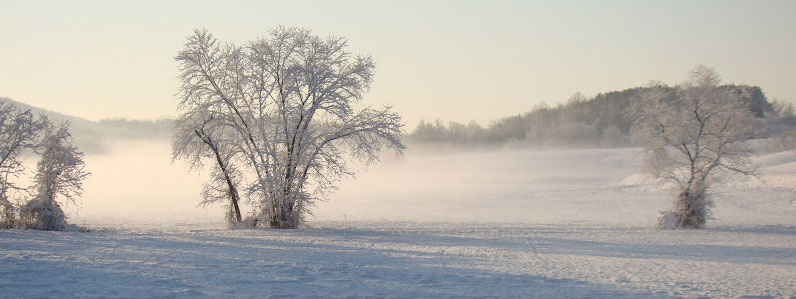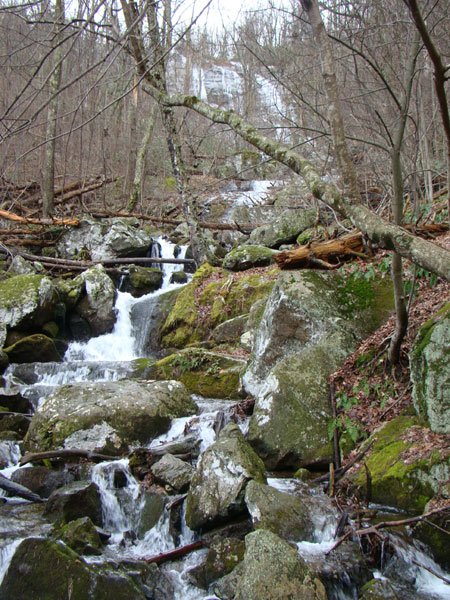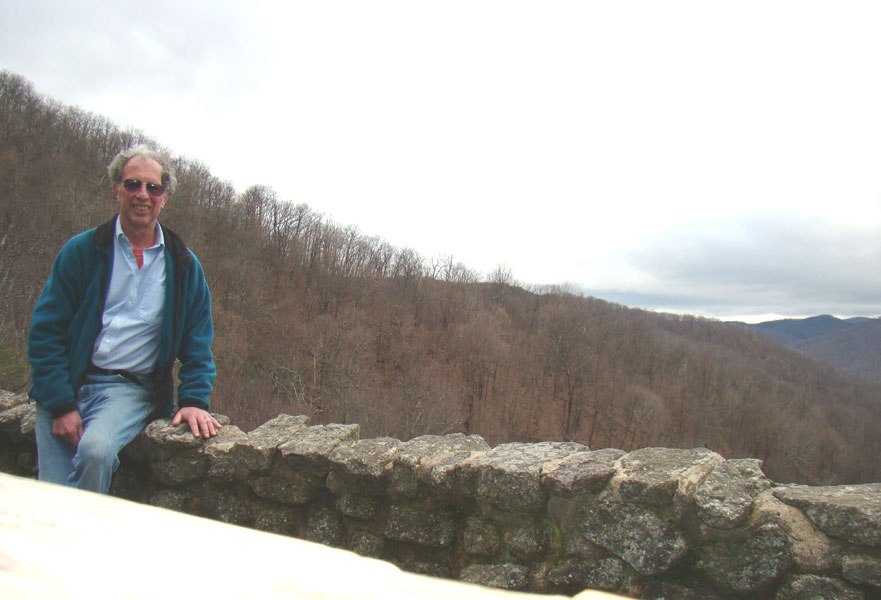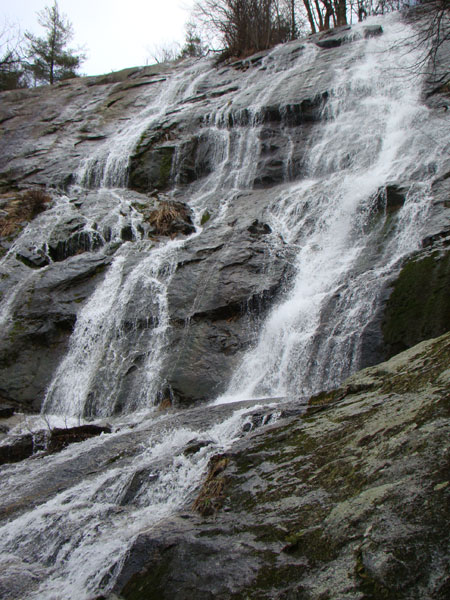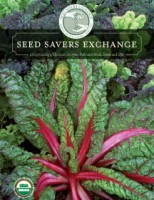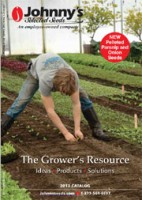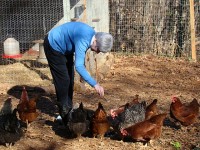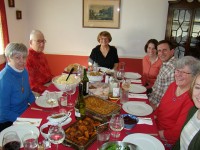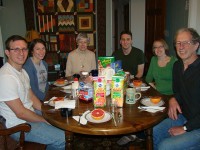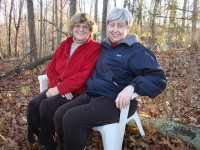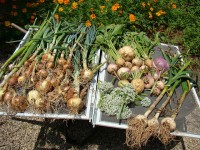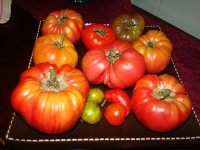I had to climb up on our roof the other day to clean out the gutters, and took these pictures from the rooftop.
Sat 12 May 2012
Rooftop Views of Paradise
Posted by Bob under Flower/Rock Gardens, Nature, Our New Home
No Comments
Sun 6 May 2012
After the Rain: April Visitors and Blooms
Posted by Bob under Family and Friends, Flower/Rock Gardens, Nature, Vegetable Garden
No Comments
After three and one-half weeks without a drop of rain from late March to mid-April, spring rains finally came, much to everyone’s relief. (While not all Nelson County folks are directly engaged in agriculture, all understand the importance of rain.) The following weekend we had a delightful visit from my cousin Fred Brack, whom I hadn’t seen in 30 or so years, his wife Kathy, and Kathy’s seeing-eye dog, Wilda. Our next get-together will happen sooner. Below: Fred, Kathy and Wilda at Crabtree Falls, and with Monika at a local winery.
Due to the mild winter and warm spring, flowers continue to bloom several weeks earlier than normal. Especially striking this spring have been the roses Monika planted two years ago in front and back of our house, and the three different clematis which were already in the front when we bought the place. Monika’s inspiration also led us to reconfigure the pond area in the back with two little “zen” rock gardens.
Despite the dry spell which slowed things down for a while, we’re reaping the benefits of early spring plantings: lettuce, chard, spinach and turnips are ready to eat, and snap peas are now a good three feet up their trellis and blooming. And we have plenty of basil, chives, cilantro, parsley, rosemary, and thyme. Potato plants are ready for hilling. I put out a dozen varieties of heirloom tomatoes, which I’d started under grow lights in March, in the last week of April. Still planting various types of beans, squash and, for the first time: peanuts! (a mild addiction of mine)
click here for more flower and veggie garden pictures
Our various projects have kept us pretty busy around our home, but I did bike the rails-to-trails route along the Piney and Tye Rivers, which has recently been extended, making for a 14 mile round trip. A lovely path, with lots of spring wildflowers in bloom.
Sun 1 Apr 2012
March Garden, Blooms, and Visits
Posted by Bob under Family and Friends, Nature, Vegetable Garden
No Comments
It’s impressive and heartening how many Nelson County residents have vegetable gardens, although it is striking to me how few plant spring vegetables. Apart from summer tomatoes, snap and snow peas are probably my favorite veggie to grow and eat; I planted several trellis’ worth in the first week of March, and we should be munching on them by mid-May. Lettuce, swiss chard, spinach, and turnips, also planted from seed, are all coming along, as well as cilantro, parsley, collards, and kohlrabi, which I started under grow lights in February and transplanted into the garden a week ago. The biggest job was planting 20 pounds of seed potatoes (we just ate our last potato from last year’s harvest this past week). This year’s varieties are: Satina, Carola, Yukon Gold, and Kennebec.
After our mild winter, we’ve had an unusually warm early spring. Daffodils started blooming in the first week in February, and many trees and shrubs have begun flowering several weeks earlier than normal. This is always a beautiful time of year, with our forsythia, weeping cherry, crabapple, serviceberries, and dogwoods bursting with color. And our apple trees (a retirement gift from my department at Rutgers) have apple blossoms for the first time.
Our chickens continue to keep us well-stocked with eggs, and three frogs have taken up residence in our little backyard pond. Five-lined skinks are all around, and bluebirds and chickadees appear to be setting up shop in our bird houses. Our local pileated woodpeckers continue to make periodic appearances. Monika and I have been undertaking several major projects in the back, most notably so far a rock and pebble path out to the kennel and chicken coop.
Long-time friends from Vermont, Jan and Harris, visited us in the third week of March, followed by a delightful family gathering with Eleanor, Justin, Katherine, Nic, and Alison. With beautiful weather almost every day, our early spring has been lovely, although most everyone around here is concerned about the relative lack of rainfall.
Mon 20 Feb 2012
Our 24 Hour Winter
Posted by Bob under Chickens, Nature
[3] Comments
We’ve had a generally mild and snowless winter–until mid-afternoon yesterday. This was our hens’ first experience of snow, and they didn’t take to it. They promptly headed not just into their run, but most of them continued right on into the henhouse. In mid-morning when we open up the outer door to the run, the hens generally come charging out: today one black australorp gingerly took a few steps out, looked back at all the others who were hesitating, and ran back in herself. (Cold by itself they have no problem with. But chickens are…chicken.)
In any case, Monika and I enjoyed the snowy afternoon and evening by our wood stove, and then the beautiful vistas in the sun this morning, here and down by the Tye River.   By afternoon, the four inches of snow were rapidly melting away. And the hens were pecking away at the remaining small clumps of snow.
click here for more pictures of our 24 hour winter
Thu 9 Feb 2012
A Country Day: Beauty and Death
Posted by Bob under Chickens, Nature
No Comments
Today began with this beautiful view out our living room window, as the full moon was going down and the early sun rays beginning to reach the trees. And it’s turned into another gorgeous day, still without snow this season. While pruning our butterfly bushes in the back, I looked over to our chicken run and saw one of our Wyandottes lying on the ground, looking dead, which she proved to be when Monika and I examined her. It appears that she died from a problem with an ill-formed egg in her cloaca canal. This was our first loss since the death of one Black Austalorp in (mail) transit from the hatchery. We buried her with sadness in our back yard, at least knowing that she had a good life here.
Thu 12 Jan 2012
Training for Summer AT Hike Begins
Posted by Bob under Appalachian Trail, Hiking/Sauntering, Nature
No Comments
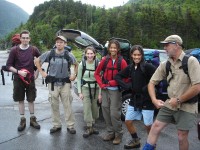 Â
 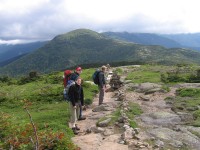
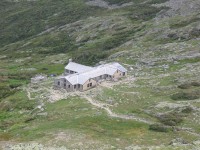
Above: the 2007 expedition team en route to Lake of Clouds Hut
In June 2007, an annoying accident prevented me from being part of a family hike I’d planned on the Appalachian Trail in the White Mountains, New Hampshire, staying at Appalachian Mountain Club huts along the way. This year Nic and Tim have sweetly taken it upon themselves to organize a repeat of the hike this summer. It’s planned for this coming July and I’m very much looking forward to it! [Note: pictures from the 2007 expedition can be seen in three pages at our family website, and there’s also a YouTube video of the second day based on pictures taken by Nic, Alison, Cally, Sylvia, Justin, and my brother-in-law Lee, who fortunately was available to take my place.]
So barring another stupid accident, it’s up to me (now as a retired old geezer) to keep up with Nic and Alison and Tim and Megan this July! Accordingly, I officially began today my “training” for the hike this summer with a six-mile saunter up our local Crabtree Falls and beyond to Crabtree Meadow and back. Although there were touches of ice here and there, the temperatures were in the fifties and rain earlier in the week meant lots of water in the falls. And the lack of foliage meant that the falls were visible through the trees at all times.  Above the falls, the trail runs along the floodplain of Crabtree Creek, which below the falls feeds into the South Fork of the Tye River. There is a nice mountain laurel forest and pleasant campsites along the way. An auspicious beginning for my training regime! A few pictures of today’s hike below.
Fri 30 Dec 2011
‘Tis the Season of Seed Catalogs
Posted by Bob under Vegetable Garden
No Comments
 Seed catalogs used to arrive in January; then it became December. And this year they started arriving around Thanksgiving! But since I’m a sucker for these things, it would be silly to complain.
Seed catalogs used to arrive in January; then it became December. And this year they started arriving around Thanksgiving! But since I’m a sucker for these things, it would be silly to complain.
For sheer size, coffee-table-style lavishness, diversity and excitement, Baker Creek Heirloom Seed catalog earns my first place, as it has for several years. Reflecting the vision, diligence, and quite astounding success of Jere Gettle, it invites the reader (yes, not just the shopper) to return to it again and again.  The full-page pictures are stunning and constitute an education in themselves. This year’s catalog coincides with the publication of Jere’s first book (with his wife Emilee), The Heirloom Life Gardener: The Baker Creek Way of Growing Your Own Food Easily and Naturally. The book provides a refreshingly non-intimidating introduction both to contemporary food production issues and to basic techniques of vegetable gardening, with an excellent A-Z glossary on growing, harvesting, eating, and seed-saving individual veggies. I recommend it highly, especially for those recently bitten by the gardening bug.
My other three favorites have been the same for several years, and each has its special virtues: Seed Savers Exchange (nicely-illustrated and informed by this non-profit membership organization’s pioneering commitment to the preservation and distribution of heirloom seeds; Southern Exposure Seed Exchange, based in Virginia with a strong regional focus; and Johnny’s Selected Seeds, an employee-owned company that successfully markets to both professional growers and amateur gardeners and is a good source of gardening supplies as well as seeds. Catalogs for each may be ordered by clicking on the respective images.
Thu 29 Dec 2011
Christmas in Maryland
Posted by Bob under Family and Friends, Travel
No Comments
 Â Â
  
Moni and our Christmas tree at home
Nic and Alison stopped by on their way north before Christmas, and we had dinner at the recently-opened restaurant of the Wild Wolf Brewery, which, while having the best food of the three Nelson County breweries, didn’t quite meet expectations. Still, we had a good time (and the beer remains great) and we plan to go back when the beer garden opens up in warmer weather. Tim and Megan also stopped by on their way back from Lynchburg after Christmas.
In between, Monika and I drove up to John and family in Maryland, crossing the Potomac via White’s Ferry, and spending a delightful Christmas Eve and Christmas with John, Calista, Cally, Sylvia and Hazel (dog). While we went lightly on presents, they thoughtfully gave us a dehydrator, which we’ve already put to work drying apple slices, with delicious results. More dehydrating reports sure to follow.
click here for more pictures of Christmas in Maryland
Sun 27 Nov 2011
A Blessed Thanksgiving
Posted by Bob under Chickens, Family and Friends, Farms and Food
No Comments
“Blessed” is very much part of Southern vocabulary–sometimes with an explicit religious connotation but otherwise simply constituting a recognition of the many things we cannot take personal credit for but that enrich our lives deeply: the extraordinary beauty of our surroundings in Nelson County, the expanding web of friendship we’ve become part of, the local knowledge and resourcefulness we’ve benefited from, and much more. And at Thanksgiving this year, we felt blessed not only to have Nic and Alison, Tim and Megan, and my sister Eleanor with us, but be able to share in their impressively interesting and productive lives.
More of a surprise was the bonding that went on between Eleanor and our chickens, whom she was “meeting” for the first time. Eleanor became the main egg collector, snack provider, and even poopy cleaner-upper for the time she was here, and she shared in the pleasure we take from simply sitting in the chairs alongside the outer pen and watching the antics and machinations of our flock of fourteen hens.
Our Thanksgiving turkey was an organically-raised and free range Midget White from Tall Cotton Farm (not that midget at twenty pounds), a breed we were surprised to learn has not only been rated as the best-tasting turkey by Mother Earth Magazine but was developed by a plant geneticist at the University of Massachusetts in Amherst, from which Tim and Megan just received their Ph.D.’s in Computer Science. We were joined at dinner by two local friends, Mikel and Linda, and it was a lovely time. Later on, we introduced the kids to Recipe, a card game we’d learned down here from our (93 year-old!) friend and neighbor, Virginia Page, whom we also feel blessed to know.
click here for more Thanksgiving pictures
Wed 16 Nov 2011
2011 Veggie Garden Report
Posted by Bob under Vegetable Garden
No Comments
click here for a photo overview of our 2011 veggie garden
Here in Virginia, it’s possible to have three consecutive but overlapping gardens: Spring (March-June), Summer (July-September), and Fall (October-December). The spring garden began with seeds under indoor grow lights in February, with outdoor transplanting and direct seeding in early March. Harvesting of lettuce and spinach began in mid-April and of snap, snow and garden peas, turnips, kohlrabi, swiss chard, collards and cool-weather herbs such as cilantro between mid-May and June. Twenty-five pounds of seed potatoes were planted in the third week of March for harvesting in mid-summer. The spring garden iltself ends around the time of the harvesting of the garlic crop (planted the previous fall) in late June .
With the major exceptions of tomatoes and peppers, our summer garden is mostly planted from seed in May.  Several varieties of squash, along with cucumbers, herbs (particularly basil), edamame, Malabar Spinach, parsnips, bulb fennel, radishes, and bush beans are planted first, followed by pole beans once the pea harvest is over and trellis space is freed up. Tomato seedlings were transplanted in mid-May and pepper seedlings shortly afterward. Garden space freed up by the garlic harvest made way for winter squash seeds in late June.
As summer plants died back in August, freed-up space was planted with a mix of seeds for the fall garden (turnips, kohlrabi, and for the first time, rutabega) and purchased seedlings (lettuce, chard, kale, collards), mostly harvested between October and early December.
What’s missing in the account above are the ways things didn’t always go as planned: rabbits eating all the edamame down to the ground, fungal diseases on most tomato plants which limited their productivity and eventually killed off many, problems with proper storage for the garlic crop, etc. Taking these sorts of things into account, I’d grade my garden success with about a B for 2011–most things went well, but there were some notable problems.
For details that probably are mainly of interest to me as a record, you can click on the “more” tag below.
